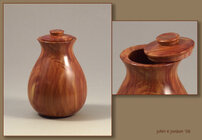What's the grain orientation that would be a good way to start out?
Faceplate orientation like a bowl or spindle orientation?
Or does it not matter so much? Chuck a chunk of fire wood and let it rip?
Faceplate orientation like a bowl or spindle orientation?
Or does it not matter so much? Chuck a chunk of fire wood and let it rip?

